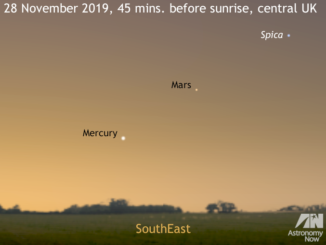
If the dawn sky of Monday, 13 November is clear, then observers in Western Europe including the British Isles will witness a close conjunction of Venus and Jupiter. About 40 minutes before sunrise in the UK on this day, the two planets have an angular separation of a mere 16 arcminutes — roughly half the width of the full Moon. Timing is everything as the pair rise just 1.4 hours before the Sun as seen from the heart of the UK, but if you leave it too late then the sky will be too bright to see them. The best time to look is around the start of civil twilight when the Sun is 6° below the horizon.
For observers in selected cities in the UK, the start of civil twilight (GMT) is tabulated below:
6:37am Norwich 6:56am Liverpool 6:39am London 7:04am Aberdeen 6:49am Birmingham 7:04am Edinburgh 6:51am Leeds 7:08am Glasgow 6:52am Cardiff 7:11am Belfast 6:53am Manchester 7:11am Lerwick 6:53am Plymouth 7:13am Inverness 6:55am Newcastle
For other locations, be sure to consult our interactive Almanac to find out when civil twilight starts.
Given that Venus and Jupiter lie just 14 degrees (about 1½ spans of a fist held at arm’s length) west of the Sun on 13 November, this will be a challenging observation for observers in the British Isles. I make no apologies for offering the usual warning not to casually sweep the horizon with telescopes or binoculars near sunrise lest you accidentally view the Sun with disastrous consequences for your eyesight.
If you do manage to catch Venus and Jupiter together at the start of UK civil twilight, the pair will be just 6° above the east-southeast horizon. Seeing conditions are therefore likely to be poor, but telescope users may just catch sight of Jupiter’s four Galilean moons Io, Europa, Ganymede and Callisto in the configuration depicted at the top of the page.
Note that the circular inset shows a simulated 100× magnification erect-image telescope view. Observers using Newtonian/Dobsonian reflectors need to rotate the graphic 180° to match the eyepiece view, while users of refractors, Schmidt- and Maksutov-Cassegrains with a star diagonal should mirror the image left-right to match what they see in the eyepiece.
How close can Venus and Jupiter get?
Conjunctions of the brightest and largest planets are quite common. In recent memory, Venus and Jupiter passed within an arcminute (0.7 arcminutes, actually) on the morning of 17 May 2000, but they were too close to the Sun for observation. On the evening of 27 August 2016 the pair were just 4 arcminutes (one-fifteenth of a degree) apart. The next time that Venus and Jupiter pass closer than the 13 November 2017 event is 30 April 2022, when the pair’s separation is almost 14 arcminutes.
Venus can also occult (pass in front of) Jupiter. The last time this occurred was on 3 January 1818, but the event was visible from the Far East, and no known record of an observation exists. We have to wait until 22 November 2065 for the next occultation, but the pair will be too close to the Sun to observe. Circumstances are better for the occultation of 14 September 2123 when Venus and Jupiter lie 16 degrees east of the Sun.



